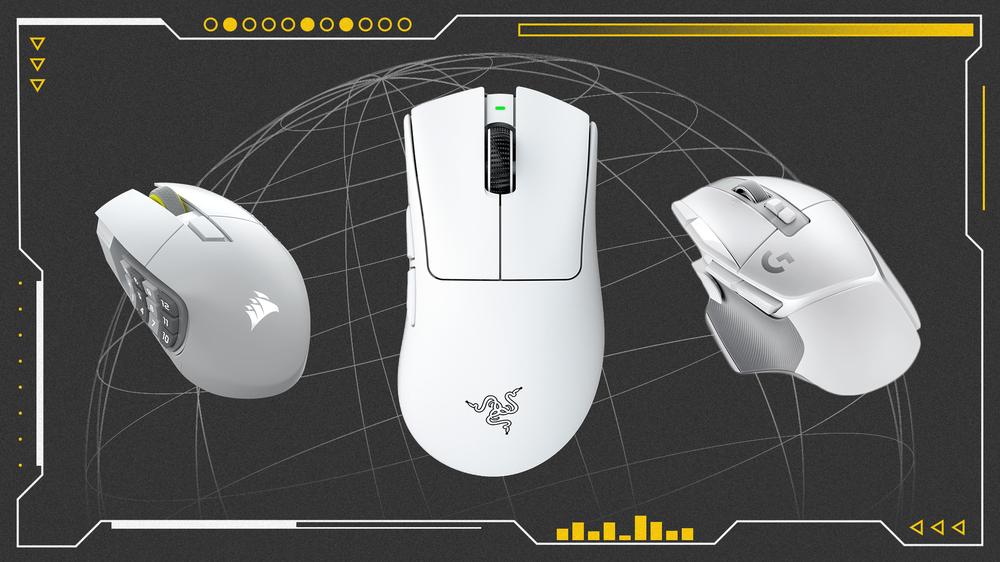There’s a plethora of great gaming mice out there to choose from. But more so than picking out a great gaming headset, finding the right mouse has a lot to do with personal preference. Don’t get me wrong, when reviewing gaming mice, several factors make some demonstrably better than others, but you’ll want to consider things like weight, size, ergonomics, extra buttons, or even what types of games you play. Because of this, I’ve broken down my picks for best gaming mouse based on a number of categories to help you make the best choice for your needs.
For example, the Logitech G502 X Lightspeed is one of the most comfortable mice that prioritizes ergonomics, but I would recommend the Viper V3 Pro to those who want an edge in competitive rounds of Valorant. Some may even want a versatile gaming mouse that makes sense in work settings with good Bluetooth and battery life, which the Turtle Beach Pure Air fits admirably. Meanwhile, those extra buttons on the Corsair Scimitar Elite sure look nice to those who want to program all their MMO/MOBA commands off the keyboard. But if I had to just choose one mouse out of them all as a blanket recommendation, the DeathAdder V4 Pro from Razer gets my vote. Throughout this guide, I break down my hands-on experience with each of the gaming mice I recommend to showcase why I think they’re the right fit for their category.
TL;DR – These Are the Best Gaming Mice
Of course, these aren’t the only great gaming mice – products have matured over the years so features like sensor accuracy, responsiveness, and durability are better than ever, and anything worth its salt will have those bases covered. That said, there are still many aspects to consider when it comes to new technologies and features being crammed into modern mice. With that in mind, at the end of the guide I’ve outlined some important questions to ask when looking for a gaming mouse on your own. And as always, we’ll update this guide with new recommendations as we get hands on and review more gaming mice in the future, so be sure to check back whenever you need some buying advice.
See our list of the best gaming mouse pads, too!
Additional contributions by Danielle Abraham
Best Overall Gaming Mouse
Best Budget Gaming Mouse
Best Budget Wireless Gaming Mouse
Best Wired Gaming Mouse
Best Wireless Gaming Mouse
Best FPS Gaming Mouse
Best MMO/MOBA Gaming Mouse
Most Versatile Gaming Mouse
Best Small Gaming Mouse
Best Lightweight Gaming Mouse
Best Ergonomic Gaming Mouse
How do you determine what makes a good gaming mouse?
Much of what makes a good gaming mouse comes down to your personal preferences or what exactly you want to get out of a mouse. For example, I wouldn’t recommend the Viper V3 Pro to someone who wants a compact versatile mouse that’s still good for gaming – but I would for an aspiring Valorant pro! While I certainly have my own preferences, testing and reviewing a wide variety of mice over the years has opened me up to the intricacies between different models, giving me the opportunity to experience first-hand what makes one better than another.
The first thing you’ll want to consider is your preferred grip style: palm, claw, or fingertip. Generally, a bigger mouse is a better choice for palm grips while lighter and smaller mice are better suited for fingertip grips. Do you like having a more ergonomic feel with deep-set grooves for your thumb and pinky to help hold onto the mouse? Does using something super lightweight matter more for when you’re whipping the mouse around during clutch moments in Counter-Strike 2? For me, I gravitate towards the latter since I’m most comfortable with a claw grip.
Again, it comes down to preference, but reviews will illustrate the way different mice contour to the user’s hands and how weight factors into whether or not it is easy to wield. Some mice are ambidextrous/symmetrical, which should work just fine for right-handed users while giving lefties out there a viable option. However, mice built specifically for right-hand use may fit more like a glove for, well, right-handed players.
Button feel is a tough thing to suss out when researching mice, but I make it a point in my mouse reviews to determine the squishiness or springiness of mouse clicks since that’s an important factor for both comfort and performance. Manufacturers tend to differ on the kinds of mechanical switches used from mouse to mouse, but the more firm and tactile the clicking feels, the better, since it helps with rapid firing in shooters or repeated clicks in MMOs/MOBAs.
Another feature that’s become standard is programmable side buttons. Most mice offer two around the thumb area, but they come in all shapes and sizes. Comfortable positioning and being easy to actuate in a moment's notice are things we account for when determining whether or not a mouse’s side buttons are good. You may also be interested in mice that go the extra mile with additional buttons, such as the ergonomic-minded Logitech G502 or the MMO/MOBA powerhouse that is the Corsair Scimitar Elite – they’re nowhere near as nimble as other mice, but that’s the compromise they make to offer those unique benefits.
Another variable to account for is the sensor, which tracks movement. Almost every brand name gaming-grade mouse today is equipped with an accurate and fast optical sensor that’s more than enough to line up shots in a competitive shooter. A higher maximum DPI (dots-per-inch, which is one variable that affects sensitivity) used to be shorthand for a mouse’s performance ceiling, but it has gotten to the point of diminishing returns.
What’s the deal with high polling rate on gaming mice?
Gaming mice come standard with a 1000Hz polling rate nowadays, which means your mouse updates your PC with movements and inputs every millisecond (1 ms). That’s plenty fast for most gamers, but a recent trend born out of the esports world is equipping mice with higher polling rates – up to 8000 Hz. Pro-grade mice such as the Razer Viper V3 Pro and Asus Keris II Ace are capable of this, offering polling rates of 1000 Hz, 2000 Hz, 4000 Hz, and 8000 Hz. It’s technically impressive, but does it really affect performance? It can, under specific circumstances.
Polling Rate
Response Time
Battery Life*
1000 Hz
1 ms
100 hours
2000 Hz
0.5 ms
70 hours
4000 Hz
0.25 ms
40 hours
8000 Hz
0.125 ms
20 hours
* General range using the Razer DeathAdder V3 HyperSpeed as an example.
Polling rate doesn’t necessarily reduce latency, rather it increases the frequency at which your mouse movements are read. This can lead to an increase in smoothness since your PC is picking up and tracking the more incremental movements. Basically, polling rate is the measurement of how often the mouse sends data to your device (see chart above).
However, you won’t be able to actually reap the benefits if the rest of the input pipeline isn’t up to snuff. Two things to keep in mind are the resolution you’re playing at and the refresh rate of your screen. With higher pixel density (and screen space), the more those incremental movements matter. But also, higher refresh rates (such as 144 Hz and above) are important too. To benefit from those high refresh rates, your PC needs to be powerful enough to produce the high frame rates to match. In other words, there’s a lot that goes into PC gaming before you can start to notice the advantage of a mouse’s higher polling rate.
Part of me thinks of it as tech simply striving for higher numbers, but I must admit I feel a difference when using a higher polling rate (when the aforementioned conditions are met). And in the esports scene, those seemingly negligible differences can certainly help. Which is to say, don’t go out and get a 8000 Hz mouse and think you’ll reach Radiant in ranked Valorant without putting in the work.
Should I go wired or wireless for a gaming mouse?
Similar to optical sensors with fast and accurate tracking, wireless technology has gotten to the point where it’s very much imperceptible to tell the difference in input latency between wired and wireless mice. The standardization of the 2.4 GHz wireless receiver makes mouse performance consistent across several brands and models, so it’s not something you’ll need to account for when looking for a good gaming mouse. Various brands will put fancy names on proprietary tech, like Razer’s HyperSpeed or Logitech’s Lightspeed, but those are wireless technologies that are legitimately high-performing. Some mice also come fitted with Bluetooth connectivity, which makes them versatile in work or casual settings, but under no circumstances should you use a mouse in Bluetooth mode for intense gaming scenarios.
Another feature that has evolved substantially over the years is battery life on wireless mice. Plenty of variables go into battery life, and usually the rating you get from a manufacturer’s website is likely under the best conditions. But even with RGB lighting and sophisticated sensors and wireless technologies, you can get decent battery life that’ll last for a few days of constant use before having to charge. Every modern gaming mouse is chargeable through USB-C and can be used like a wired mouse when plugged in, too. As indicated in the chart above with regards to polling rate, the higher it is, the more power it’ll drain since you’re essentially asking your mouse to work much harder.
Many flagship mice have wired and wireless versions available – such as the DeathAdder V4 or the Scimitar Elite, for example – and of course, the wireless ones are more expensive. So if you don’t really care much for having wireless capabilities, you can save some money by opting for the wired mice. Note that if you’re interested in higher polling rates, it’s currently restricted to wireless mice, which also tends to tack on a few extra bucks onto the price tag.

 ICE Propaganda Video That Used Jay-Z Song Hit With Copyright Takedown
ICE Propaganda Video That Used Jay-Z Song Hit With Copyright Takedown